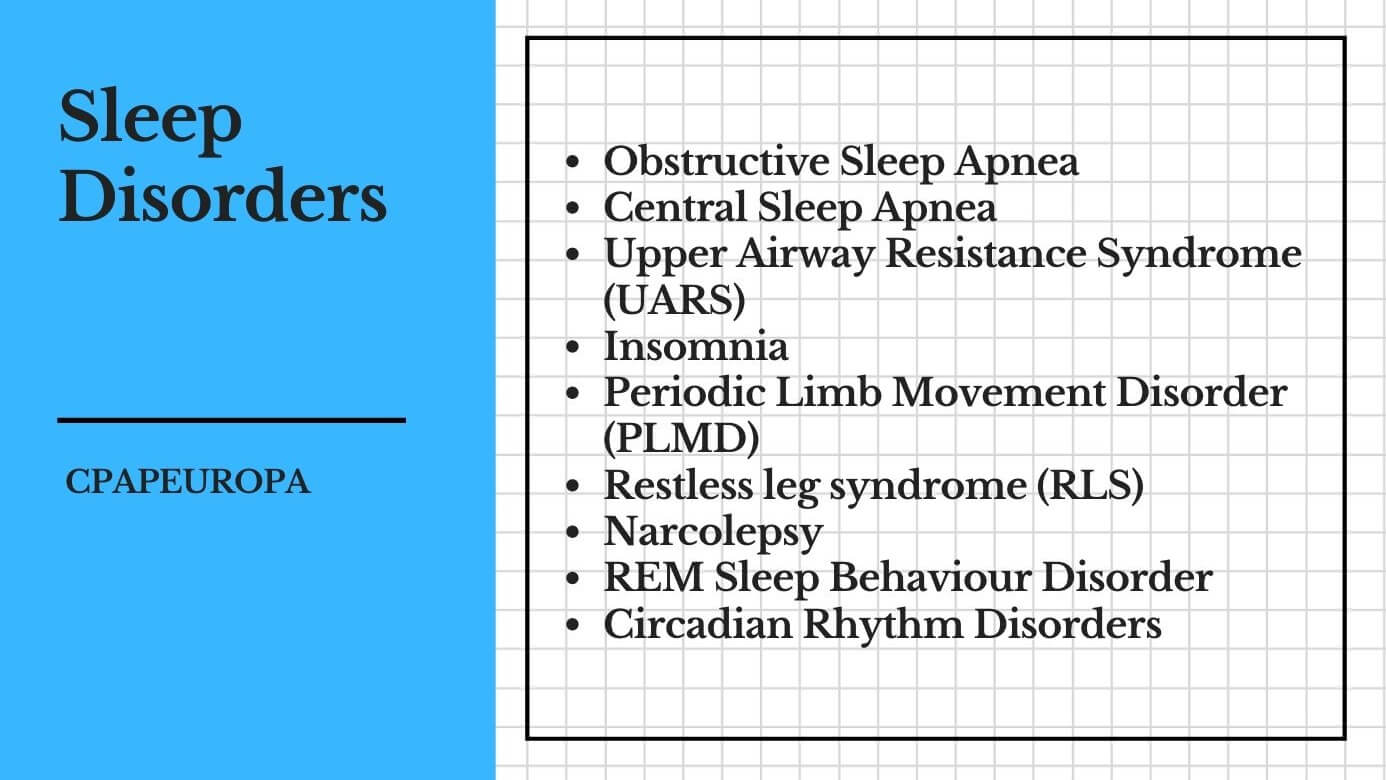Did you know that there are more than 95 identifiable sleep disorders? Yes, that many!
One of the most frequent ones is obstructive sleep apnea (OSA), which is estimated that affects more than 900 million people on the planet. No one can say the exact number of OSA sufferers because the vast majority of them do not even realize they have the disorder until diagnosed. To read more about obstructive sleep apnea, please visit our Sleep Apnea guide here. To learn about the other major types of sleep disorders, keep reading.
Obstructive Sleep Apnea
The most frequently met type of sleep apnea. The obstructive type prevents normal breathing during sleep because the sleeper’s airways collapse and block the oxygen supply to the lungs. The sleeper stops breathing briefly and starts to breathe again only when the brain sends a panic signal to the body to resume. The sleeper produces a loud gasp or snort – the most identifiable sound after an apneic event. These breathing pauses sometimes last up to one minute in the most severe forms of the disorder.
Central Sleep Apnea
Central sleep apnea (CSA) is caused not by an obstruction in the airways but by a brain dysfunction. In short, your body can breathe but your brain doesn’t tell it to do so. This type is usually caused by a serious illness, oftentimes by a dysfunction of the lower brainstem. Fortunately, central sleep apnea is less common than OSA, with less than 1% of the general population in the US suffering from it.
Upper Airway Resistance Syndrome (UARS)
Upper airways resistance syndrome is rather rare sleep disorder causing disruptions to sleep due to a narrowing of the airway. The main symptoms include difficult chronic insomnia, daytime fatigue and breathing during sleep, the last two if which are also present in obstructive sleep apnea.
Insomnia
Another ‘modern’ sleep disorder affecting hundreds of million people in the world, insomnia is characterized by difficulty falling and staying alseep. Often caused by both psychiatric and medical conditions, insomnia is the main reason for sleeplessness worldwide, often followed by daytime sleepiness, depression, high irritability, mood swings, and poor concentration. In addition, insomnia is sometimes linked to sleep apnea, as it is a symptom of an underlying sleep disorder like OSA.
Periodic Limb Movement Disorder (PLMD)
Periodic limb movement disorder (PLMD) is a sleep disorder where the patient’s limbs movie involuntarily during sleep. although resembling the symptoms of restless legs syndrome (RLS), the two interchangeable and should not be confused with one another. PLMD sufferers have no control over the episodes of limb movement during sleep. They often fall asleep during the day and find it difficult to fall / stay asleep at night (resembling insomnia, see above).
Restless leg syndrome (RLS)
Restless leg syndrom, also known as Willis-Ekborn disease, is a sensory-motor disorder characterized by a strong, almost irresistible need for the patient to move his legs. As these unpleasant sensations occur more often at rest, they are most pronounced in the evening. This often leads to difficulty falling asleep and insomnia. There are two main types of RLS: primary and secondary — the former is categorized as idiopathic, while the latter is associated with certain medical conditions or drug usage.
Narcolepsy
Fortunately, one of the most dangerous sleep disorders – narcolepsy, is also one of the most rare ones. Narcolepsy occurs in only 0.02 – 0.05% of people. However, its consequences are extremely serious for the sufferer, because it makes it difficult for them to socialize. High drowsiness and the constant of falling asleep caused by the disease can lead to developmental delays and severely impaired quality of life. Narcolepsy usually occurs around the age of 15 and less frequently between the ages of 30 and 40.
REM Sleep Behaviour Disorder
REM stands for “rapid eye movement” — a sleep behaviour disroder (also known as parasomnia). The disorder makes the sleeper act out their dreams, and involves physical movement of limbs and even getting out of bed and sleep walking, screaming and, sometimes, even hitting other people nearby. The REM sleep behaviour disorder is thus considered to be dangerous to the sleep walker, as they have no control of their actions while dreaming, and may lead to self-injury or injury to other people. Fortunately, medication including benzodiazapine eliminates the symptoms in 9 out of 10 cases, as well as certain antidepressants and melatonin.
Circadian Rhythm Disorders
Circadian rhythm sleep disorders are an entire group of more than six most common disorders, most often caused by desynchronization between internal sleep-wake rhythms and the light-darkness cycle. A prime example of a circadian rhythm disorder is jetlag — an asynchronization of the body clock. Circadian rhythm disorders are typically characterized by insomnia, daytime sleepiness, and more. The most common ones are shift work sleep disorder, delayed sleep phase syndrome, advanced sleep phase syndrome and irregular sleep-wake rhythm disorder.

